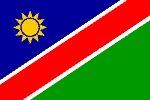
Namibia
NAMIBIA: Strategies to keep patients on ARVs
NAMIBIA: New report reveals hidden poverty
White Zimbabwe farmers win legal ruling
NAMIBIA: Government steps up birth registrations
NAMIBIA: Bonita Nakanyala: "There is no way I will disclose my client's status to them."
NAMIBIA: Small town, BIG grant
Official Name: Republic of Namibia
Geography
Capital: Windhoek
Major Towns: Windhoek, Swakopmund, Luderitz, Ondangwa
Location (geographical coordinates/latitude and longitude): Windhoek: 22°33'S, 17°15'E
Time Zone: WAT (UTC+1)
Size (Land and Sea): 825,418 km², Water: negligible
Borders with Angola, Zambia, Botswana, South Africa, Atlantic Ocean
Elevation extremes: Lowest point: Atlantic Ocean 0 m, highest point: Konigstein 2,606 m
Politics
Head of State: President: Hifikepunye Pohamba, Prime Minister: Nahas Angula
Form of Government: Republic
Independancy (from South Africa): March 21, 1990
Currency: Namibian Dollar
Industry
Main Industries: meatpacking, fish processing, dairy products; mining (diamonds, lead, zinc, tin, silver, tungsten, uranium, copper).
Natural resources: diamonds, copper, uranium, gold, lead, tin, lithium, cadmium, zinc, salt, vanadium, natural gas, hydropower, fish; note: suspected deposits of oil, coal, and iron ore
Agriculture: millet, sorghum, peanuts, grapes; livestock; fish
Population and People
Population: 2,055,080 (2007 est.); 2031000 (2005 est.), 1,820,916 (2002);
Population density: among the three sovereign countries with the lowest population density with per sq mi: 6
Population Growth rate: 0.5% (2007 est.)
Birth rate: 23.5 births/1,000 population (2007 est.)
Total fertility rate: 2.94 children born/woman (2007 est.)
Infant mortality rate: 47.2/1000
Religion: Christian 80% to 90% (Lutheran 50% at least, other Christian denominations 30%, native religions 10% to 20%
Languages: English, Afrikaans, German, Oshivambo, Herero, Nama
Ethnic groups / Tribes: Black 87.5%, white 6%, mixed 6.5%
Age structure: 0-14 years: 37.7% (male 390,448/female 383,698); 15-64 years: 58.6% (male 606,239/female 597,512); 65 years and over: 3.8% (male 34,926/female 42,257) (2007 est.)
Life expectancy: 43.1
Literacy: Total population: 38%, male: 45%, female: 31% (1960 est.)
coming
 Text Area - Namibia
Text Area - Namibia Content List - Namibia News
Content List - Namibia News Map - Namibia Map
Map - Namibia Map